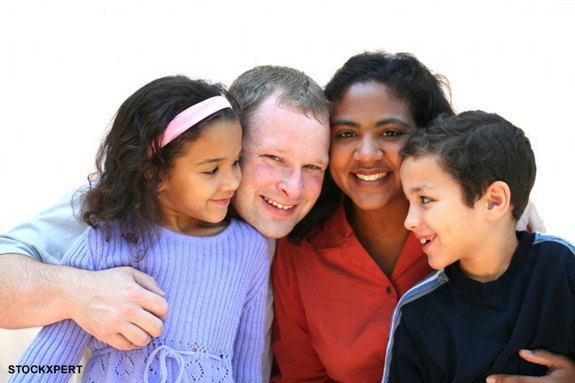Interracial Couples Invest More in Kids

Parents who are of different races, such as a white father and an Asian-American mother, spend more time and money on their kids than parents who are both of the same race, new research shows.
So-called biracial (aka interracial or multiracial) parents are more likely than their "monoracial" counterparts to provide their children with a home computer, private schooling and educational books and CDs and to make sure they participate in reading activities, dance, music or art lessons outside of school and get trips to the zoo, library and other cultural venues.
The "biracial advantage" only holds for comparisons with same-race couples from the two racial groups represented by the parents—for instance, if a Latino and white couple is compared with a Latino-Latino couple or a white-white couple. The finding disappears if all biracial couples, regardless of racial pairing, are compared with the entire pool of same-race couples (combining all couples that are white-white, black-black, Latino-Latino and so forth).
The advantage, or higher investment, can be explained as a counterweight or response to the social challenges faced by interracial couples, who only gained legal acceptance in the United States in 1970 when the U.S. Supreme Court overturned a state law in Virginia that prohibited whites from marrying non-whites, said study author Brian Powell at Indiana University Bloomington.
The ruling invalidated similar bans in 15 other states.
The number of biracial couples has since more than tripled, yet many couples still face disapproval and prejudice, Powell said.
"They face challenges in being a couple," he said in a prepared statement. "They're aware of the challenges their children will be facing. In turn, they try to compensate for this."
Get the world’s most fascinating discoveries delivered straight to your inbox.
Powell said he was not surprised by the finding that the biracial nature of families may represent a source of advantage, rather than hardship, for children.
"What we find is pretty similar to the findings for other families that are not seen as your typical family—older parents are seen as selfish, adoptive parent are seen as people who have no quote 'biological' connection to the children, interracial couples are said to ignore the challenges the child has by being interracial," Powell told LiveScience. "In all cases, those claims are completely wrong in terms of what we are finding."
The study, detailed in the American Journal of Sociology, examined data collected in 1998–1999 as part of a large national survey of U.S. families, with a focus on those with kindergarteners. A total of 1,599 couples were part of the new analysis.
Powell and his colleague Simon Cheng at the University of Connecticut found one exception to the "biracial advantage." Black father/white mother families tend to invest fewer resources into kids than do black monoracial couples and white monoracial couples.
This could be because families in which one of the parents is black likely experience greater prejudice and disapproval from their extended families than do non-black interracial couples, Powell and Cheng wrote. Also, there seem to be greater social challenges faced by couples in which a non-white man is involved with a white woman, they wrote.
The study also highlighted the great variation in U.S. biracial couples. Couples with one black parent and one white parent made up the smallest set—just 143 couples, compared to 601 in which one parent was Latino and the other white. There were 174 white and Asian couples and 191 couples who were white and "other," which referred to Native Americans among others.
Robin Lloyd was a senior editor at Space.com and Live Science from 2007 to 2009. She holds a B.A. degree in sociology from Smith College and a Ph.D. and M.A. degree in sociology from the University of California at Santa Barbara. She is currently a freelance science writer based in New York City and a contributing editor at Scientific American, as well as an adjunct professor at New York University's Science, Health and Environmental Reporting Program.



